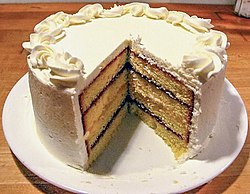This article has multiple issues. Please help improve it or discuss these issues on the talk page . (Learn how and when to remove these messages)
|
 | |
| Alternative names | Butter Icing |
|---|---|
| Type | Icing or filling |
| Main ingredients | Fats (usually butter; sometimes lard or margarine), powdered sugar |
Buttercream, also referred to as butter icing or butter frosting, is used for either filling, coating or decorating cakes. The main ingredients are butter and some type of sugar.
Contents
- Varieties
- American buttercream or mock cream
- Meringue-based buttercream
- Other varieties
- See also
- References
Buttercream is commonly flavored with vanilla. Other common flavors are chocolate, fruits, and other liquid extracts. Food coloring is commonly added if the buttercream is being used as decoration. Buttercream can be piped or spread in decorative patterns and shapes.
